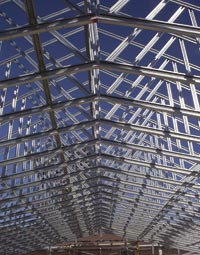By Alex Mcgillivray
 |
As lumber prices fluctuate drastically, the general consensus is that the quality of wood framing material has been in decline for some time. Not only does the lumber industry strip Canada of vital resources, quality first-growth trees have either been felled or are protected, meaning that rotational forests yielding lower quality wood are bearing the burden of lumber demand.
Cold-formed steel framing is manufactured using up to 100 per cent recycled steel. It will stay square and plumb as it is a uniform quality material formed to exacting national standards. Steel framing offers much more flexibility in the planning stage as longer floor joist and truss spans can be achieved to allow more open-plan areas within the envelope. It will not crack, warp or shrink, unlike wood, which means the building envelope will stay tight and the energy efficiency value will not be compromised by popped drywall nails or bowed webs and studs, which can cause air leakage. Uncontrolled air leakage can account for between 10 and 40 per cent of heating/air-conditioning costs, resulting in increased emissions and associated energy costs.
As with any framing material, choosing the correct thermal resistance material according to local building code and the application is the key to minimizing heat loss and transfer. Steel is considerably more conductive than wood, yet with the correct measures taken and appropriate thermal resistance material a steel-framed residence will perform as well as wood in terms of energy efficiency, while offering better longevity and quality, reduced insurance premiums and non-combustibility.
Insulating Inside and Out
There are numerous insulation options and combinations available - mineral wool, glass fibre, cellulose fibre, and spray foams, to name but a few - and the manufacturers of each insulation type should be consulted to determine the most suitable material and/or combination for the application.
For areas in Canada with heating seasons up to 5000 Celsius degree days, at least 25 per cent of the required R-value of the wall assembly is to be located on the cold side of the frame. This usually entails attaching rigid insulation sheathing (expanded or extruded polystyrene) to the exterior side of steel stud walls to act as an effective thermal break. Without exterior insulation, condensation problems can occur in areas of drywall. If batt insulation is used between the studs, care should be taken to ensure that the "C" profile cavity of the stud is filled.
Floors over unheated spaces such as crawlspaces and unheated garages require insulation. Code requirements can be satisfied by using friction-fitting batts with insulating sheathing fastened to the underside of the floor joists. Sprayed insulations can be a good choice for these areas as they negate the need for insulation to be secured to the assembly. A hard finish should be applied to protect the insulation from damage and to act as thermal barrier protection. In crawl spaces and other exposed areas, the finish should provide some weatherproofing - either cement board or an appropriate exterior sheathing.
At the roof-wall intersection (a critical detail in preventing thermal bridging) insulation is placed between every truss. With cold-formed steel trusses it is common to place friction-fitting batts or blown loose fill insulation between and over the bottom chords, taking care that soffit vents are not blocked. If spray foam is to be used, batt plugs are placed at the exterior ends of the truss bottom chord to fill the profile and provide a spraying surface for the foam.


